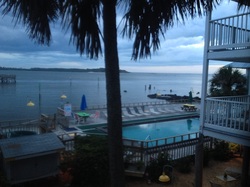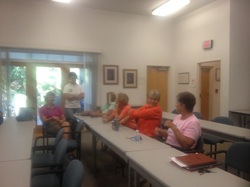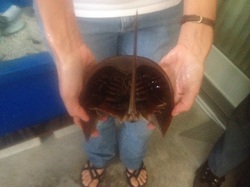Horseshoe Crab Demonstration

So the kayak fishing event was over and the drive back to the condo was a repeat convoy of earlier that morning, only in the opposite direction and minus one vehicle because Dot and Liz had called it quits earlier in the day and had already made it back to the condo. They were already taking another stroll around the town by the time the rest of the girls got there.
The next event on the agenda was the Horseshoe Crab Presentation which started at 5:30 and was back at the Marine Lab where Rebecca and Jennifer had taught the kayak fishing clinic the night before. A dip in the pool to cool off before heading back upstairs to the condo was the best idea anyone had at that moment. Fifteen minutes of swimming a few laps was all they needed to cool off and get motivated to change clothes and head to the lab but they weren't going on an empty stomach.
In the room directly below them was another group of ladies who had come to Cedar Key for the Festival as well and one of those ladies, Theresa, is a member of the NCLA club but had come to the Festival with a different group. Her husband had sent her with an especially tasty homemade lasagna dish which she was generous enough to share with the girls in the upstairs unit. When they got back to the room from kayak fishing all day, all they could think of was lasagna and margaritas.
The next event on the agenda was the Horseshoe Crab Presentation which started at 5:30 and was back at the Marine Lab where Rebecca and Jennifer had taught the kayak fishing clinic the night before. A dip in the pool to cool off before heading back upstairs to the condo was the best idea anyone had at that moment. Fifteen minutes of swimming a few laps was all they needed to cool off and get motivated to change clothes and head to the lab but they weren't going on an empty stomach.
In the room directly below them was another group of ladies who had come to Cedar Key for the Festival as well and one of those ladies, Theresa, is a member of the NCLA club but had come to the Festival with a different group. Her husband had sent her with an especially tasty homemade lasagna dish which she was generous enough to share with the girls in the upstairs unit. When they got back to the room from kayak fishing all day, all they could think of was lasagna and margaritas.

Now they were ready to go to the Marine Lab where Tiffany Black, an FWC crustaceans biologist introduced an amazing living fossil that is the horseshoe crab and explained its life history. She discussed the historic and current use of horseshoe crabs, their importance in the ecosystem and shared some very interesting statistics such as:
* There are a total of only four different species of horseshoe crabs worldwide
* Females can weigh as much as 20 lbs.
* Females are larger than males
* They are not actually crabs. They are more related to spiders, scorpions and tics
* Males have pincers and females do not
* Females have longer legs for nest digging
* It takes a female 10 years to reach maturity.
* She can lay over 100,000 eggs
* She can dig and lay eggs in as many as 10 different nests in one hour
* They cannot be successfully farmed at this time
* They molt
* Their last molt is called their "terminal" molt
* They nest year-round in Florida
* Jane Brockman is the resident expert on the subject
* 10% die each year from being flipped upside down accidentally
* Their tail is very sensitive and have photo receptors which act as 'eyes'
* They should be picked up by the sides and not the tail
* They have blue blood
* A compound in their blood is harvested for medical research
* There are a total of only four different species of horseshoe crabs worldwide
* Females can weigh as much as 20 lbs.
* Females are larger than males
* They are not actually crabs. They are more related to spiders, scorpions and tics
* Males have pincers and females do not
* Females have longer legs for nest digging
* It takes a female 10 years to reach maturity.
* She can lay over 100,000 eggs
* She can dig and lay eggs in as many as 10 different nests in one hour
* They cannot be successfully farmed at this time
* They molt
* Their last molt is called their "terminal" molt
* They nest year-round in Florida
* Jane Brockman is the resident expert on the subject
* 10% die each year from being flipped upside down accidentally
* Their tail is very sensitive and have photo receptors which act as 'eyes'
* They should be picked up by the sides and not the tail
* They have blue blood
* A compound in their blood is harvested for medical research

She drew her presentation to a close by letting the class know that the general public can help in valuable horseshoe crab research. There is a website dedicated to gathering data on horseshoe crab sightings and anyone who spots one is encouraged to report it on the following site:
http://www.research.MyFWC.com
The entire talk turned out to be very interesting and informative and while some of the 'students' stuck around to ask her more in-depth questions, others were heading out the door and on their way to the Community Center where the official Festival Dinner was being served.
http://www.research.MyFWC.com
The entire talk turned out to be very interesting and informative and while some of the 'students' stuck around to ask her more in-depth questions, others were heading out the door and on their way to the Community Center where the official Festival Dinner was being served.
 RSS Feed
RSS Feed